"EN PLEIN AIR": OUTDOOR SCREENINGS TO FIGHT THE VIRUS
by Angelica Riva
The Covid-19 pandemic has shaken the cinema industry more than it ever has been: since spring 2020 we have gone through general lockdowns to gradual re-openings with distancing, only to return to new - more localised - restrictions to protect public health. One of the first reactions to the impossibility of indoor screenings was to bring back drive ins. And suppose that, in the future of the cinema, there might be a prospect for bringing back to life some of the atmosphere that made the spectators of “Grease” dream, bringing the American style of the ‘Fifties up to date and offering it to present-day and future generations?
As regards Italy, this John Travolta and Olivia Newton-John tradition has never really been absent from the country, as emerges from the analysis carried out by MEDIA Salles.
This overview cannot help but start by paying homage to the pioneer of drive ins in Italy: the Metro Drive in of Casal Palocco in Rome. designed by the architect Eugenio Galdieri, a pupil of Pier Luigi Nervi, it was inaugurated in 1957 and remained operational up until the ‘Eighties, though in 2015 a special screening was still organised there.
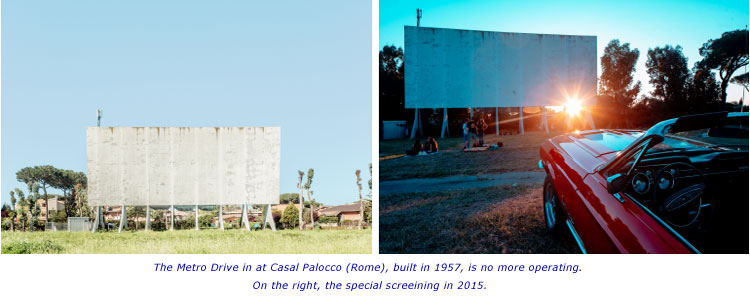
Structures offering programming with some continuity are to be found in Campania: the Garden Movie of Caserta and the Pozzuoli Drive in, which seem to have held out even against the second wave of closures, guaranteeing programming with reduced time slots that respect the curfew.
Since summer 2020, necessity has led Italians to appreciate the trend towards a comeback by the legendary drive in. In these structures screenings have concerned mostly films that have made cinema history, whilst waiting for new productions to abandon streaming platforms on the small screen and be released in movie theatres. The top screen of all - famous all over Europe for having the biggest, permanent maxi-screen (250 square metres) - is the Drive in cinema Paolo Ferrari at Ostia Lido. But there are also the Starlight Drive in in Pontedera, Province of Pisa, and, for Roman audiences, the Sunset Drive in in the Cinecittà studios and the Drive in in Cassia.
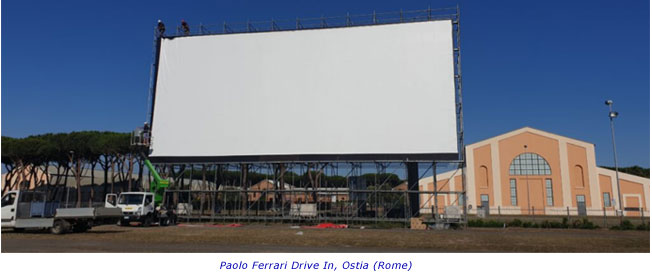
Amongst the open spaces in the Bel Paese that have been turned into authentic open-air theatres where it is possible to watch a film from 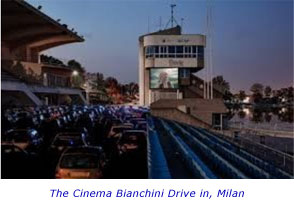 your own car, in Northern Italy, in the Veneto Region, a striking example is provided by the parking lot of the ex-hospital in Marostica which, for ten evenings, from 8 to 17 August 2020, offered the opportunity to enjoy masterpieces of the big screen from the more or less distant past, for a vintage-style experience.
your own car, in Northern Italy, in the Veneto Region, a striking example is provided by the parking lot of the ex-hospital in Marostica which, for ten evenings, from 8 to 17 August 2020, offered the opportunity to enjoy masterpieces of the big screen from the more or less distant past, for a vintage-style experience.
And Milan has shown no intention of lagging behind, not only in terms of the drive in experience, but in terms of open-air cinema in general. Indeed several big screens have been set up in the provincial capital of Lombardy, for example close to the Parco Nord, as well as at the Idroscalo, both of which operated every weekend until the end of the summer.
The latter venue was an initiative by the Cinema Bianchini, in collaboration with Infinity TV, with the objective of enabling cinema-going in drive in mode. This approach gave continuity to the approach of the Bianchini which, back in 2017, was already working on bringing back to life the great successes of the past in unique and unexpected locations,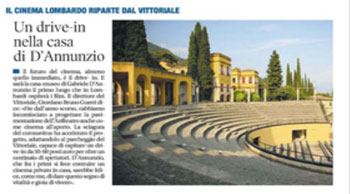 for example from Milan"s rooftops, on board a boat on the Darsena or on icy ski slopes.
for example from Milan"s rooftops, on board a boat on the Darsena or on icy ski slopes.
The initiatives for bringing back the glory of the drive ins do not end here. Lombardy"s Regional Government has announced a pilot project for transforming the car park of Gabriele D"Annunzio"s Vittoriale, on Lake Garda, into a cinema for up to 60 parking spaces for around a hundred spectators. Thanks to Silentdisco technology, the sound is delivered directly to a spectator headset.
As well as the drive ins, in the summer season other initiatives made it possible to watch a film safely in the open air. Amongst these is the “Piccoli Cinema Paradiso”, the fruit of the#iorestoacasaproduction (“Imstayingathomeproduction”) initiative: on the Roman coast, on the fine dunes of Capocotta beach, – thanks to collaboration from the 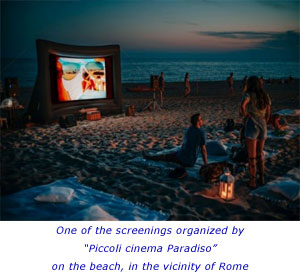 managers of five kiosks - holidaymakers were transformed into audiences, taking part in a shared “film week”, in which, thanks to an online poll, they were able to indicate the films to be screened. The key element in this experimental initiative was the inflatable screen which, in times of pandemic, proved to be a precious ally for open-air screenings more or less everywhere in the world.
managers of five kiosks - holidaymakers were transformed into audiences, taking part in a shared “film week”, in which, thanks to an online poll, they were able to indicate the films to be screened. The key element in this experimental initiative was the inflatable screen which, in times of pandemic, proved to be a precious ally for open-air screenings more or less everywhere in the world.
One of the screenings organized by “Piccoli cinema Paradiso” on the beach, in the vicinity of Rome
A glance at the website “Airscreen”, the German company specialised in the production and distribution of inflatable screens, is sufficient to see how extraordinarily widespread this sort of equipment is, having reached over a hundred and twenty countries. Initially used for open-air events, such as concerts or cinema festivals, in parks, municipal centres, university campuses, stadiums, beaches or places where the landscape is of special interest and would not allow for a permanent structure, during this long pandemic the inflatable screen has represented - and still does - a handy resource for cinema exhibitors in search of rapidly implemented solutions, such as drive ins or open-air screenings.

 And, in view of the fact that open-air activities meet with the approval of the public institutions that dictate the conditions for a return to a “more normal” life and reassure the public, the new modes of enjoying films on the big screen will not necessarily fail to last well after the end of the emergency.
And, in view of the fact that open-air activities meet with the approval of the public institutions that dictate the conditions for a return to a “more normal” life and reassure the public, the new modes of enjoying films on the big screen will not necessarily fail to last well after the end of the emergency.
(Per leggere il testo in italiano cliccare qui)